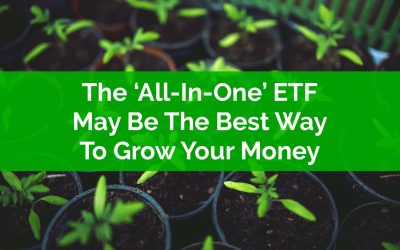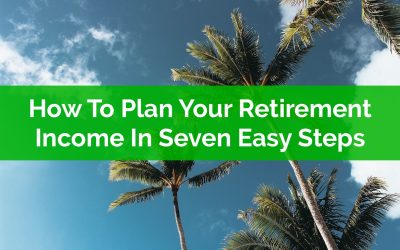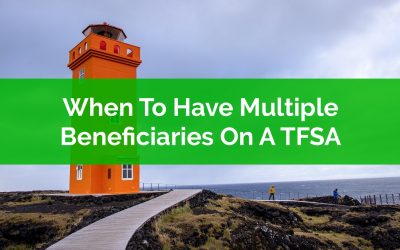Congratulations! You’re on the waitlist!
We will e-mail you before the bootcamp launches for an exclusive preview.
Check out our latest blog posts…
Why The All-In-One ETF Might Be The Best Way To Grow Your Money
The average investment portfolio in Canada consists of high-fee mutual funds but over the last few years we’ve seen the introduction of multiple new ways to invest. These new ways to invest are typically low-cost, highly diversified, and easy to manage. They’re a welcome change to the typical high-fee mutual fund portfolio that many Canadians use to invest.
The average mutual fund portfolio in Canada has investment fees of around 2.5% per year. On a $100,000 portfolio that’s $2,500 per year in fees. On a $500,000 portfolio that’s $12,500 per year in fees. And on a $1,000,000 portfolio that’s $25,000 per year in fees! That’s quite the drag on investment returns.
These are astronomical figures, especially when investors aren’t receiving the level of planning and advice that should be expected with these types of fees.
These fees are also not very easy to find, they’re typically hidden on the statement, or they’re split between advisor fees and investment management fees, so it’s very difficult to see how much you’re actually being charged. When looking at the typical investment statement it’s very hard for the average mutual fund investor to see that they’re paying such high fees each year.
One of the reasons these high-fee portfolios are so prevalent is because until recently, the main alternative to a high cost mutual fund portfolio was to do it yourself (DIY). This required setting up a self-directed brokerage account and it also meant buying and selling individual securities or perhaps ETFs. This can be very daunting for a long-time mutual fund investor.
But recently things have started to change. In the last 3-5 years we’ve seen multiple new ways to invest. These new ways to invest are easy, convenient, highly diversified, and low-cost. They’re typically built on an “index investing” philosophy. They’re not trying to “beat the market” but instead match the market return and dramatically lower fees. These new ways to invest include robo-advisors and the new “all-in-one” ETF.
Investing of course isn’t all about fees. There are many things to consider when creating an investment portfolio. But in my opinion the “all-in-one” ETF provides an amazing balance of all these factors and they may be the best way to grow your money.
Let’s take a look at some of the factors you should consider when creating an investment portfolio and, in my opinion, why the “all-in-one” ETF provides the best overall balance for the typical investor.
How To Plan Your Retirement Income In Seven Easy Steps
Planning retirement income is one of the most challenging aspects of a retirement plan. There are often multiple income sources of income to plan for, as many as 5+ for individuals, and as many as 10+ for couples. These income sources also “phase in” at different times throughout retirement.
Here are some of the most common sources of retirement income…
1. Government pensions like…
– CPP (Canada Pension Plan)
– OAS (Old Age Security)
2. Defined benefit pensions
3. Registered accounts like RRSP/RRIF
4. Locked-in registered accounts like LIRA/LIF (and Defined Contribution Pension Plans)
5. Government benefits like GIS
6. TFSA accounts
Understanding how much income to expect from each of these income sources can be a challenge. They may start at different times in retirement, they may also increase with inflation or not.
On top of understanding how much income these different sources may provide it’s also important to understand how they’re taxed. Some of these income sources are taxed differently. Some are also eligible for income splitting at different points in retirement. This income splitting is a distinct tax advantage for couples and shouldn’t be ignored.
In this post we’re going to look at the seven most common sources of retirement income and some of the planning considerations to keep in mind when planning your retirement income.
Warning: Because of the complexity when planning retirement income it’s impossible to fully highlight all the nuances for each of these sources of retirement income in one post. If you feel uncomfortable planning your retirement income then please speak with a professional (ideally an advice-only financial planner) about building a custom retirement plan. Understanding the phasing of retirement income sources, the tax implications, and the possible government clawbacks on benefits like GIS is well worth the money.
When To Have Multiple Beneficiaries On A TFSA
A TFSA is often the last account that we want to draw on in retirement. There are some great tax advantages to the TFSA because it allows contributions to keep growing tax free even in late retirement. New contribution room is accumulated each year and the account also regains the contribution room the following year after withdrawals have been made.
Because the TFSA is often the last to get drawn down in retirement this means that the TFSA will most likely make up a large portion of any future estate.
How large can a TFSA get? It’s reasonable to expect that with new contributions and investment growth we’ll see many TFSAs in the $1M to $2M range in the future!
The potential size of TFSAs in the future makes it important to understand how TFSAs can be passed on after death. There are a few options to consider and one option is to have multiple beneficiaries on a TFSA.
But is having multiple beneficiaries on a TFSA the right option for your estate plan? In this post we’ll look at why you may want to name multiple beneficiaries on your TFSA and some of the other options you may want to consider.



